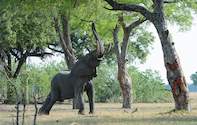
Firstly let's answer the obvious question:
Why do elephants knock down trees?
Elephants break trees as a way to get easier access to the leaves, roots and nutrients in the tree. This destructive behaviour actually benefits other species as well and seeds can be dispersed helping new trees to grow,
For years, scientists have debated how big a role elephants play in toppling trees in South African savannas. Using high resolution 3-D mapping, Carnegie scientists have for the first time quantitatively determined tree losses across savannas of Kruger National Park.
They found that elephants are the primary agents—their browsing habits knock trees over at a rate averaging six times higher than in areas inaccessible to them. The research also found that elephants prefer toppling trees in the five to eight meter range, with annual losses of up to 20 percent in these height classes. The findings were published in Ecology Letters and the results could help to improve savanna management practices.
"Previous field studies gave us important clues that elephants are a key driver of tree losses, but our airborne 3-D mapping approach was the only way to fully understand the impacts of elephants across a wide range of environmental conditions found in savannas," commented lead author Greg Asner of Carnegie's Department of Global Ecology. "Our maps show that elephants clearly toppled medium-sized trees, creating an "elephant trap" for the vegetation.
These elephant-driven tree losses have a ripple effect across the ecosystem, including how much carbon is sequestered from the atmosphere." The technology used for monitoring trees is Light Detection and Ranging (LiDAR), mounted on the fixed-wing Carnegie Airborne Observatory (CAO). It provides detailed 3-D images of the vegetation canopy at tree-level resolution using laser pulses that sweep across the African savanna.
The CAO's lasers can detect even small changes in each tree's height, and its vast coverage is far superior to previous field-based and aerial photographic evaluations. The scientists considered an array of environmental variables spread over four study landscapes within Kruger and in very large areas fenced off to prevent herbivore entry.
For years, four of these exclosures have kept out all herbivores larger than a rabbit. Two other partial enclosures have permitted entry of herbivores other than elephants. The scientists identified and monitored 58,000 individual trees from the air, inside and outside of these exclosures and across the landscape in 2008 and again in 2010.
They found that nearly nine percent of the trees decreased in height in two years, and that the mapped changes in treefall were linked to different climate and terrain conditions. Most tree losses occurred in lowland areas with more moisture and on soils high in nutrients that harbor trees preferred by elephants for browsing.
Critically, the partial exclosures definitively identified elephants, as opposed to other herbivores and fire, as the major agent of tree losses over the two-year period. "These spatially explicit patterns of treefall highlight the challenges faced by conservation area managers in Africa, who must know where and how their decisions impact ecosystem health and biodiversity. They should rely on rigorous science to evaluate alternative scenarios and management options, and the CAO helps provide the necessary quantification," commented co-author Shaun Levick.
"This collaboration between external scientists and conservation managers has led to exciting and ground-breaking new insights to long-standing questions and challenges. Knowing where increasing elephant impacts occur in sensitive landscapes allows park managers to take appropriate and focused action.
These questions have been difficult to assess with conventional ground-based field approaches over large scales such as those in Kruger National Park," says Danie Pienaar, head of scientific services of SANPasrks. Journal reference: Ecology Letters search and more info provided by Carnegie Institution for science search.

 While everyone agrees that elephants eat both grasses and leafy material from shrubs and trees, some debate has been ongoing in scientific c...
While everyone agrees that elephants eat both grasses and leafy material from shrubs and trees, some debate has been ongoing in scientific c...